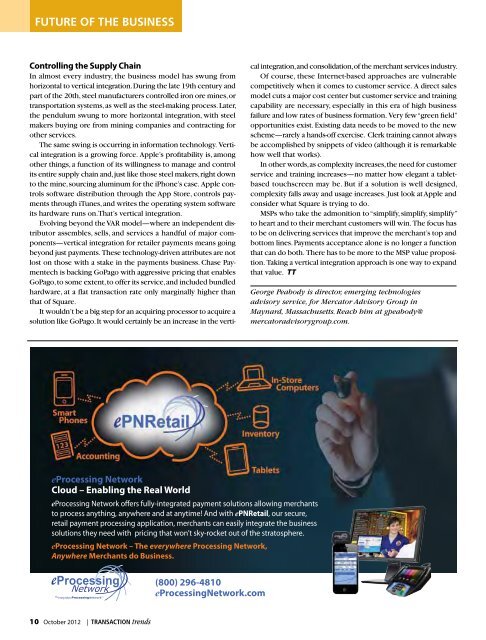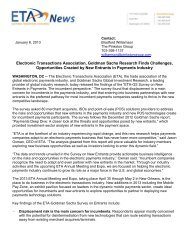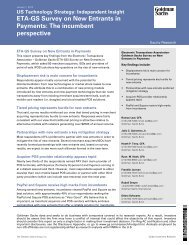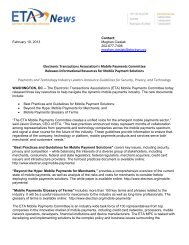Download PDF version - Electronic Transactions Association
Download PDF version - Electronic Transactions Association
Download PDF version - Electronic Transactions Association
- No tags were found...
Create successful ePaper yourself
Turn your PDF publications into a flip-book with our unique Google optimized e-Paper software.
ISO Future Corner of the Business<br />
Controlling the Supply Chain<br />
In almost every industry, the business model has swung from<br />
horizontal to vertical integration. During the late 19th century and<br />
part of the 20th, steel manufacturers controlled iron ore mines, or<br />
transportation systems, as well as the steel-making process. Later,<br />
the pendulum swung to more horizontal integration, with steel<br />
makers buying ore from mining companies and contracting for<br />
other services.<br />
The same swing is occurring in information technology. Vertical<br />
integration is a growing force. Apple’s profitability is, among<br />
other things, a function of its willingness to manage and control<br />
its entire supply chain and, just like those steel makers, right down<br />
to the mine, sourcing aluminum for the iPhone’s case. Apple controls<br />
software distribution through the App Store, controls payments<br />
through iTunes, and writes the operating system software<br />
its hardware runs on. That’s vertical integration.<br />
Evolving beyond the VAR model—where an independent distributor<br />
assembles, sells, and services a handful of major components—vertical<br />
integration for retailer payments means going<br />
beyond just payments. These technology-driven attributes are not<br />
lost on those with a stake in the payments business. Chase Paymentech<br />
is backing GoPago with aggressive pricing that enables<br />
GoPago, to some extent, to offer its service, and included bundled<br />
hardware, at a flat transaction rate only marginally higher than<br />
that of Square.<br />
It wouldn’t be a big step for an acquiring processor to acquire a<br />
solution like GoPago. It would certainly be an increase in the vertical<br />
integration, and consolidation, of the merchant services industry.<br />
Of course, these Internet-based approaches are vulnerable<br />
competitively when it comes to customer service. A direct sales<br />
model cuts a major cost center but customer service and training<br />
capability are necessary, especially in this era of high business<br />
failure and low rates of business formation. Very few “green field”<br />
opportunities exist. Existing data needs to be moved to the new<br />
scheme—rarely a hands-off exercise. Clerk training cannot always<br />
be accomplished by snippets of video (although it is remarkable<br />
how well that works).<br />
In other words, as complexity increases, the need for customer<br />
service and training increases—no matter how elegant a tabletbased<br />
touchscreen may be. But if a solution is well designed,<br />
complexity falls away and usage increases. Just look at Apple and<br />
consider what Square is trying to do.<br />
MSPs who take the admonition to “simplify, simplify, simplify”<br />
to heart and to their merchant customers will win. The focus has<br />
to be on delivering services that improve the merchant’s top and<br />
bottom lines. Payments acceptance alone is no longer a function<br />
that can do both. There has to be more to the MSP value proposition.<br />
Taking a vertical integration approach is one way to expand<br />
that value. TT<br />
George Peabody is director, emerging technologies<br />
advisory service, for Mercator Advisory Group in<br />
Maynard, Massachusetts. Reach him at gpeabody@<br />
mercatoradvisorygroup.com.<br />
Processing<br />
Network<br />
The everywhereProcessingNetwork SM<br />
10 October 2012 | Transaction trends
















